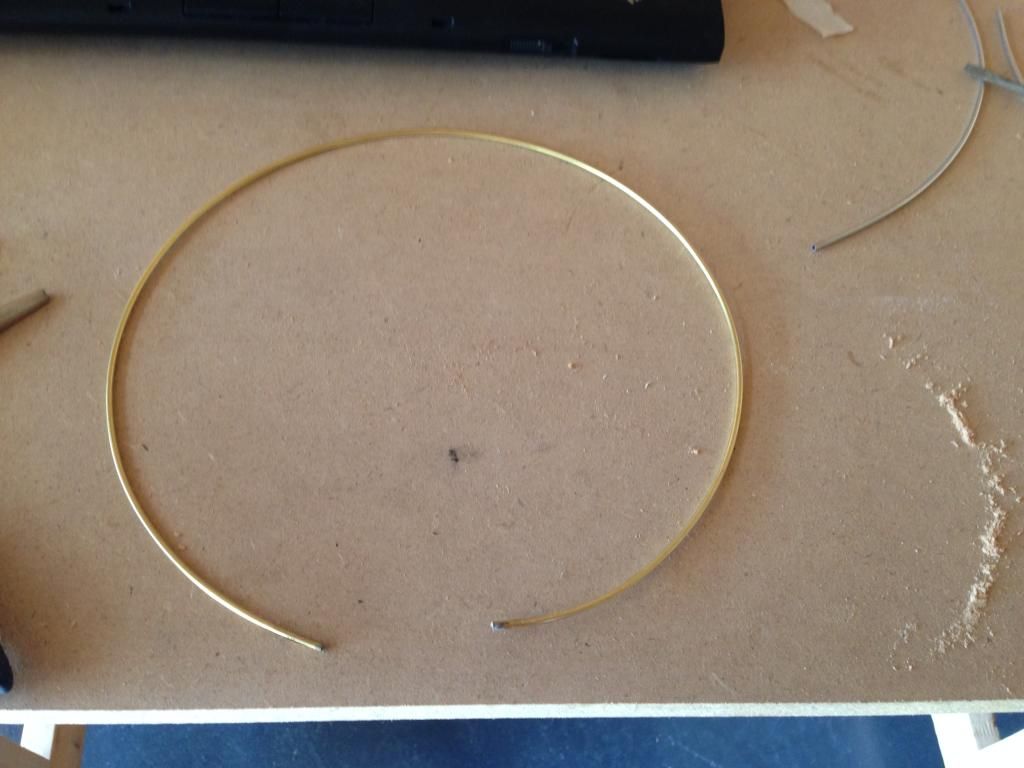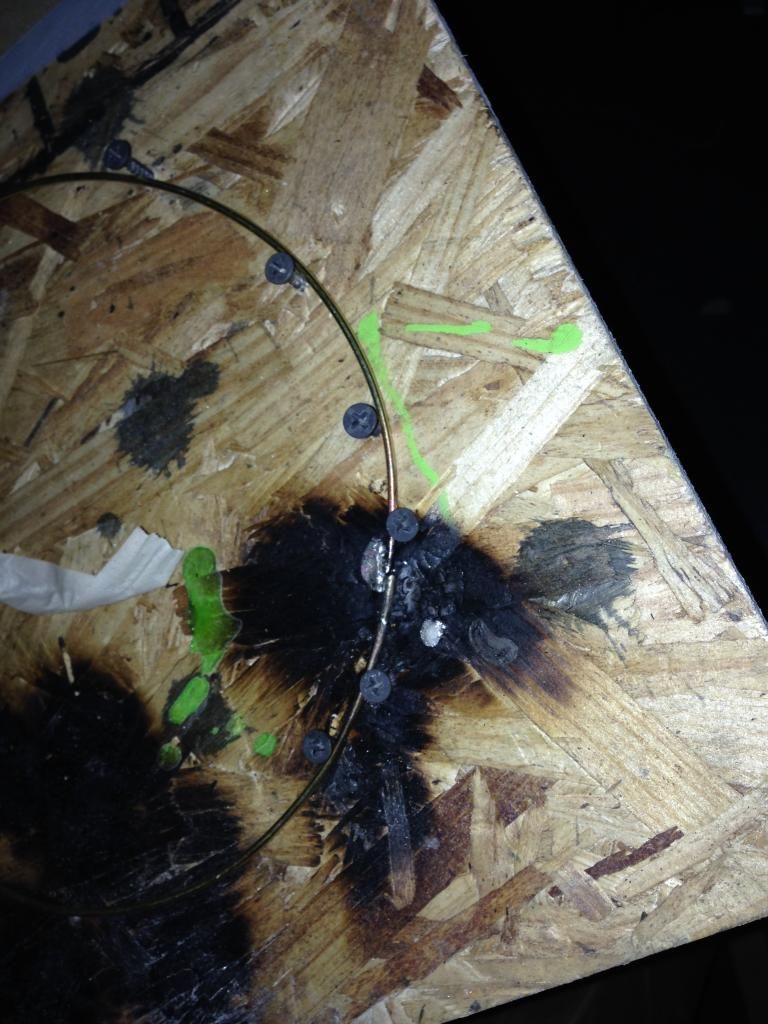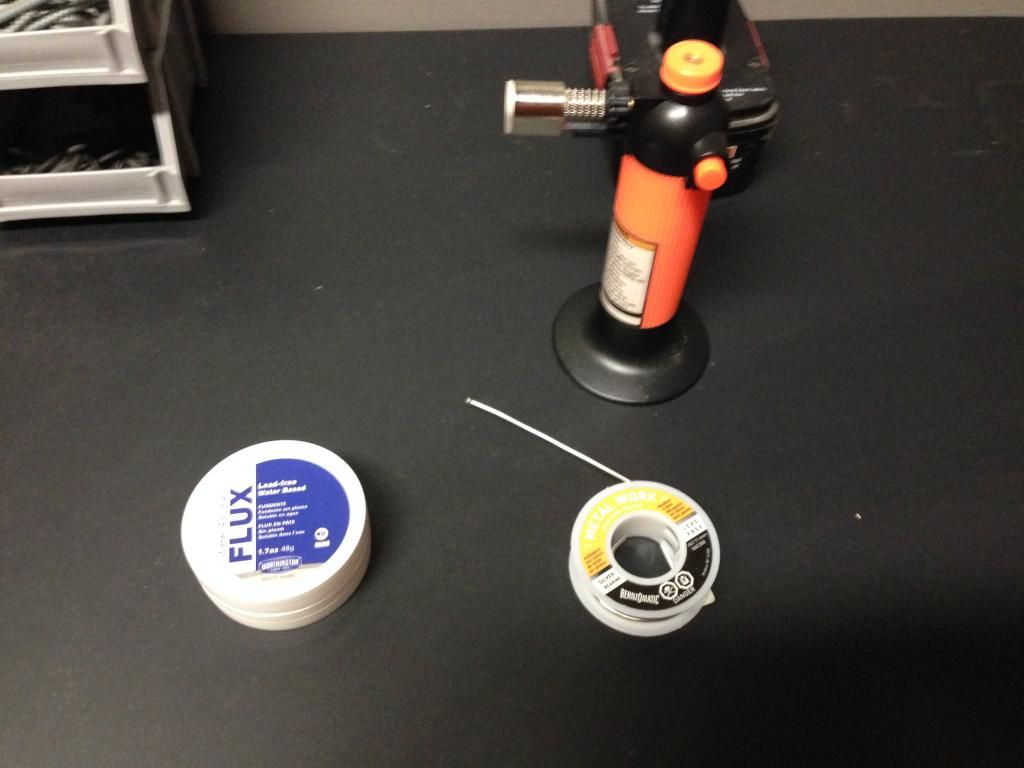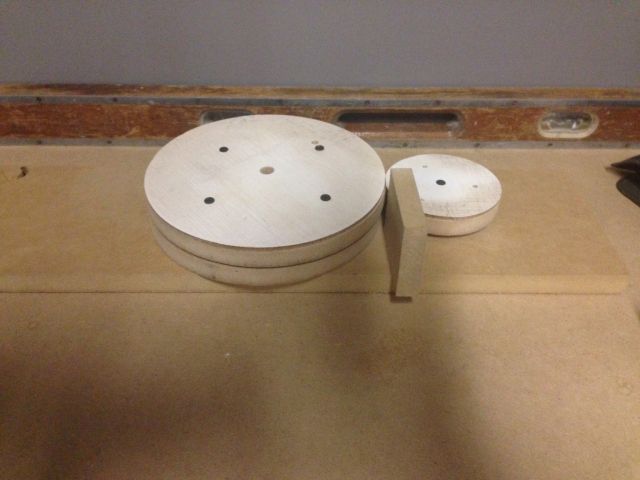You are using an out of date browser. It may not display this or other websites correctly.
You should upgrade or use an alternative browser.
You should upgrade or use an alternative browser.
Bending metal into a perfect circle
- Thread starter hdtheater
- Start date
modelcitizen
Sr Member
cool. i'm pretty sure it will work out well.
After seeing THIS video, I think if you simulated the effects of the engine blast during the launch, imperfections would be OK...
Nice, makes you wonder what the melting point of the metal is on the railings are there.
I do want to light the model from the blast crater which is why I am being so picky.
-Eric
I feel pretty good about bending the rod. I started bending it on the 8" circle I made and it sprung back way too far.

I had a 5" circle from another project that I was working on and got it to here. Pretty close I think.

My brazing/ soldering techniques needs a little help though.

The solder just beads up and doesn't want to adhere to the brass at all.
Here are the tools I am using:

I practiced on some the cut offs from the circles and could get it to hold if I overlapped the pieces increasing surface area. So, I filed down the edges to an angle to help. Still having issues.
I watched some videos on YouTube and it was like nothing for the guy doing it there. Only difference is he was using tube and I used rod.
I am sure technique is part of my problem, but to those that have been here before, is there anything wrong with the materials I am using?
Thanks,
-Eric

I had a 5" circle from another project that I was working on and got it to here. Pretty close I think.

My brazing/ soldering techniques needs a little help though.

The solder just beads up and doesn't want to adhere to the brass at all.
Here are the tools I am using:

I practiced on some the cut offs from the circles and could get it to hold if I overlapped the pieces increasing surface area. So, I filed down the edges to an angle to help. Still having issues.
I watched some videos on YouTube and it was like nothing for the guy doing it there. Only difference is he was using tube and I used rod.
I am sure technique is part of my problem, but to those that have been here before, is there anything wrong with the materials I am using?
Thanks,
-Eric
robn1
Master Member
That's the same torch I've used, I can't read the label on your solder but if it's silver plumber's type it's the right stuff.
You need to apply heat from the opposite side of where the solder is, it will flow toward the heat as it melts. Cut a notch on the edge of your board, or better use a brick or paver stone to take the heat better. But the wood will do with a notch cut out.
I haven't done a joint like this, but I'd place the flux in the joint. Cut a small piece of solder and balance it on top, then aim the torch from below.
You need to apply heat from the opposite side of where the solder is, it will flow toward the heat as it melts. Cut a notch on the edge of your board, or better use a brick or paver stone to take the heat better. But the wood will do with a notch cut out.
I haven't done a joint like this, but I'd place the flux in the joint. Cut a small piece of solder and balance it on top, then aim the torch from below.
Darth Humorous
Well-Known Member
Not sure what videos you are watching, but if they were “sweat soldering” plumbing pipe into fittings, then that is a bit different.
When soldering, cleanliness really is next to Godliness. Use clean, fine steel wool for this. Also, more surface area helps a lot. This can be done by making a scarf joint, i.e., cutting the rod ends at an angle, the more severe the angle the more surface area. I mentioned this in a previous post, but it bears repeating, and I will try to clarify — if you wrap the rod around the former/mandrel such that both ends overlap, and THEN cut across the overlap area at a sharp angle, you will (1) not only get a scarf joint, but (2) the angles will be very very close to being the correct fit, (3) you get the increased surface area, and (4) the rod will be the correct length.
Since you are dealing with such a small diameter rod, heat should be applied with care. Of course, the flux should have already been applied to the joint before you begin heating. It is important NOT to play the flame directly to the joint (gives rise to a dirty joint)…rather, heat the rod on either side of the joint, first one side, and then the other, and repeat. WHILE you are doing this, test the joint for readiness by gently touching it with a straightened length of solder OFTEN. When the joint is hot enough, the solder will melt and flow into the joint. At this point you can ease up on the heating (or stop it completely). Once the joint has filled, do not try to add more solder; just let it cool.
Other considerations. The torch you show might not melt the rod readily, but it still might melt it, given enough time and how high you have it cranked. It is O.K. to have the flame turned up, in fact in might be necessary, but keep in mind doing so will cause things to happen very fast, and you must react quickly but not clumsily. Also, not that you would do this, but playing the flame on the thin area of the scarf joint could very easily melt it.
Hope this helps.
Mark
When soldering, cleanliness really is next to Godliness. Use clean, fine steel wool for this. Also, more surface area helps a lot. This can be done by making a scarf joint, i.e., cutting the rod ends at an angle, the more severe the angle the more surface area. I mentioned this in a previous post, but it bears repeating, and I will try to clarify — if you wrap the rod around the former/mandrel such that both ends overlap, and THEN cut across the overlap area at a sharp angle, you will (1) not only get a scarf joint, but (2) the angles will be very very close to being the correct fit, (3) you get the increased surface area, and (4) the rod will be the correct length.
Since you are dealing with such a small diameter rod, heat should be applied with care. Of course, the flux should have already been applied to the joint before you begin heating. It is important NOT to play the flame directly to the joint (gives rise to a dirty joint)…rather, heat the rod on either side of the joint, first one side, and then the other, and repeat. WHILE you are doing this, test the joint for readiness by gently touching it with a straightened length of solder OFTEN. When the joint is hot enough, the solder will melt and flow into the joint. At this point you can ease up on the heating (or stop it completely). Once the joint has filled, do not try to add more solder; just let it cool.
Other considerations. The torch you show might not melt the rod readily, but it still might melt it, given enough time and how high you have it cranked. It is O.K. to have the flame turned up, in fact in might be necessary, but keep in mind doing so will cause things to happen very fast, and you must react quickly but not clumsily. Also, not that you would do this, but playing the flame on the thin area of the scarf joint could very easily melt it.
Hope this helps.
Mark
Darth Humorous
Well-Known Member
Ooh! I would be wary of pavers if they are man-made, because they are usually made from concrete. Concrete will explosively release hot chips if heated with a torch. Don’t ask me how I discovered this.
Mark
Mark
Cut a notch on the edge of your board, or better use a brick or paver stone to take the heat better. But the wood will do with a notch cut out.
JPH
Sr Member
Okay, just throwing out and idea, but rather than BENDING a thin rod of aluminum, why not just cut one out?
Cut out the inside first with a dremel or whatever, that way you can file/sand it, THEN band saw the outside. Since you have an internal dimension die/mold, you can file/sand the outside with your cut piece wrapped around it.
If you are determined you must use a bent rod, then abuse/slap that rod when you have it wrapped around a proper diameter innercircle. Beating the metal will make it forget that it is being bent. You seem to have spent alot of time trying to crack this puzzle, cutting a piece in a circle may be your quickest answer.
Cut out the inside first with a dremel or whatever, that way you can file/sand it, THEN band saw the outside. Since you have an internal dimension die/mold, you can file/sand the outside with your cut piece wrapped around it.
If you are determined you must use a bent rod, then abuse/slap that rod when you have it wrapped around a proper diameter innercircle. Beating the metal will make it forget that it is being bent. You seem to have spent alot of time trying to crack this puzzle, cutting a piece in a circle may be your quickest answer.
That's the same torch I've used, I can't read the label on your solder but if it's silver plumber's type it's the right stuff.
You need to apply heat from the opposite side of where the solder is, it will flow toward the heat as it melts. Cut a notch on the edge of your board, or better use a brick or paver stone to take the heat better. But the wood will do with a notch cut out.
I haven't done a joint like this, but I'd place the flux in the joint. Cut a small piece of solder and balance it on top, then aim the torch from below.
Its not the plumbers type. It's for metal work, like soldering gutters back together. It actually says, not for plumbing projects on the package. Maybe this is my problem. I tried connecting to wires together this morning and that did the same thing.
LOL ditto! tell me your story and I will tell you mine. :facepalmOoh! I would be wary of pavers if they are man-made, because they are usually made from concrete. Concrete will explosively release hot chips if heated with a torch. Don’t ask me how I discovered this.
Mark
Darth Humorous
Well-Known Member
LOL ditto! tell me your story and I will tell you mine. :facepalm
This happened when I was very young. I think I was burning ants with a propane torch as they were walking across a concrete patio, or some similar stupid kid thing to do. All of a sudden, SNAP! a small divot appeared on the concrete surface under the flame tip of the torch. I didn’t feel the chip, so it must have gone in another direction. Of course, I didn’t realize there actually was a chip involved; for all I knew, the concrete evaporated, burned up, or who knows what. So, like an idiot, I applied the flame tip to a fresh area of concrete, and, lo and behold, it happened again. This time, the chip hit my arm (luckily), and it felt sharp AND hot, and impacted with force, actually cutting me. I was able to examine the chip. It was only warm by then, and I noticed that the edge surrounding the flat top surface just before it became the lumpy underside was sharp as a knife all the way around. I decided my adventures into heating concrete with a torch had come to an end.
Mark
Darth Humorous
Well-Known Member
solder wont fill a gap very well... the ends need to touch
Yes of course. I failed to mention that the ends must touch, or at least be extremely close, like paper thin or less. The gap could be bigger, and the solder might actually fill the gap, but the odds are against it.
Mark
This happened when I was very young. I think I was burning ants with a propane torch as they were walking across a concrete patio, or some similar stupid kid thing to do. All of a sudden, SNAP! a small divot appeared on the concrete surface under the flame tip of the torch. I didn’t feel the chip, so it must have gone in another direction. Of course, I didn’t realize there actually was a chip involved; for all I knew, the concrete evaporated, burned up, or who knows what. So, like an idiot, I applied the flame tip to a fresh area of concrete, and, lo and behold, it happened again. This time, the chip hit my arm (luckily), and it felt sharp AND hot, and impacted with force, actually cutting me. I was able to examine the chip. It was only warm by then, and I noticed that the edge surrounding the flat top surface just before it became the lumpy underside was sharp as a knife all the way around. I decided my adventures into heating concrete with a torch had come to an end. we
Mark
I was doing my first construction job, building concrete cold storage buildings. they use these giant steel brackets, huge bolts and nuts to connect the wall to the floor. I was just a laborer packing stuff from here to there and crap. the supervisor runs up and grabs me and we run over to the walls laying down with the brackets and bolts on. he tells me ive got to cut off the top of the bolt even with the nut. he sparks up the oxy acet. torch, shows me how to do it. so ive got to walk up and down the wall cutting them all off and the 3rd one I tipped the torch down. POP! a 3- 3 1/2 inch circle (1/2 in deep) appeared, then my right arm got warm. the shrapnel had shot up my sleeve. got lucky, like you nothing hit my face or chest as im less then 2 feet away. anyway I turned the torch off, went to my supervisor and told him to find someone else to do the rest.
Similar threads
- Replies
- 13
- Views
- 937
- Replies
- 7
- Views
- 347
- Replies
- 5
- Views
- 571

